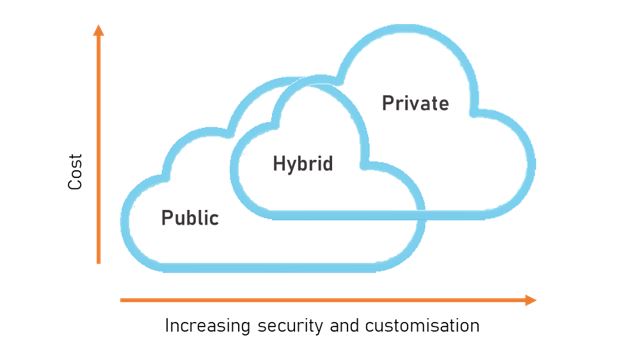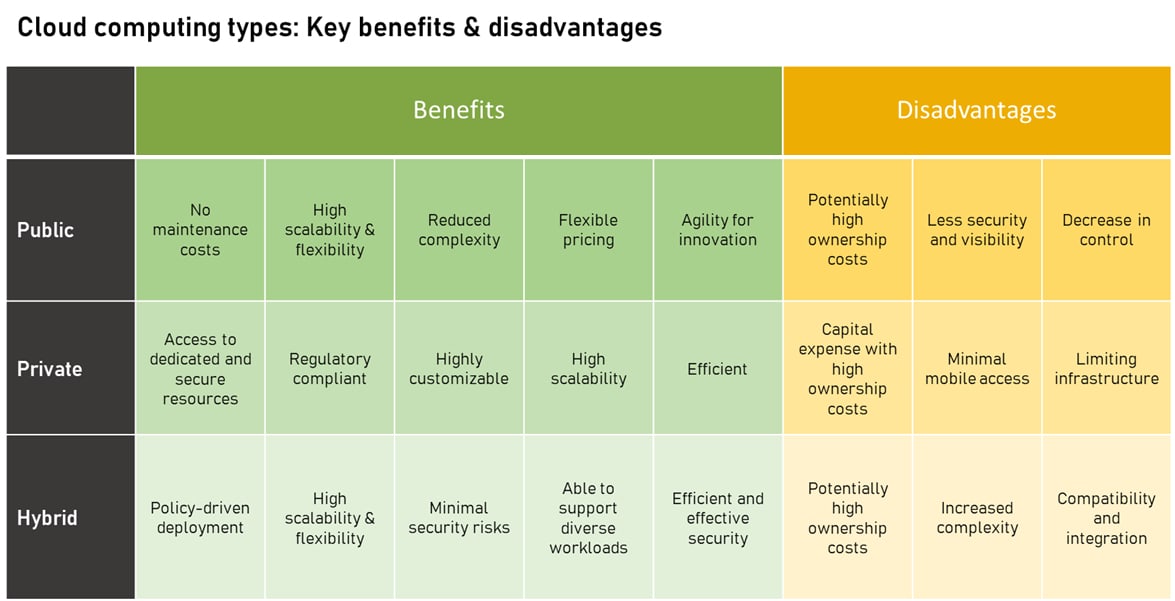Hybrid Cloud Benefits: 10 Reasons why Businesses must consider Hybrid Cloud adoption

The cloud has become significant in transitioning from traditional legacy systems to an agile structure. However, achieving a balance between controlled private cloud and public clouds can be difficult – hybrid cloud offers a variety of benefits without compromising security or compliance.
Organizations have a choice between cloud solutions and must invest time and money in determining which product best meets their needs. Several industries are embracing hybrid cloud, in particular, because it allows them to reap many of the advantages offered by both public and private clouds.
Here you can learn what hybrid cloud is and the benefits that the adoption of a hybrid cloud strategy can bring for your organization.
On this page:
What is Hybrid Cloud?
The hybrid cloud is a cloud computing platform that combines private cloud (on-premises) and public cloud services from third-party providers.
The hybrid cloud provides greater flexibility and additional data deployment options by allowing workloads to migrate between public and private cloud environments in response to changing costs and compute requirements.
A key benefit of hybrid cloud computing is that it allows an organization to establish a private cloud on-premises that can house essential and sensitive workloads while utilizing a third-party, public cloud service provider for less-critical computing resources, such as test and development workloads.
See also: Private Cloud vs Public Cloud
Hybrid Cloud Characteristics
The following are the primary characteristics of a hybrid cloud architecture:
- A business’ on-premises data centre, private and cloud resources, and workloads are connected using conventional data management while simultaneously keeping them segregated.
- The capability to connect existing systems running on conventional architectures while containing business-critical applications or sensitive data may not suit public cloud deployment.
Hybrid Cloud Scenarios
The cloud has become a significant stepping stone for many firms transitioning from traditional or out-of-date legacy systems to an agile structure. Many businesses are keen to take advantage of the the benefits offered by restructuring their business plans to leverage hybrid cloud infrastructures.
A hybrid cloud strategy allows the company to stay current, competitive, and expand with new technology while lowering the danger of falling behind.
A hybrid cloud strategy can be beneficial if your business needs to:
- Migrate to the cloud gradually and at its own pace – Some of your workloads should be moved to a public cloud or a small-scale private cloud. Examine what works best for your company and continue to increase your cloud presence as needed— either on public cloud, private cloud, or a hybrid of the two.
- Ensure flexibility for the future – No matter how carefully you plan to fulfill today’s needs, you won’t know how they will alter next month or next year unless you had a crystal ball. A hybrid cloud solution allows you to match your actual data management requirements to the resources in the public cloud, private cloud, or on-premises that are best suited to handle them.
- Segregate critical workloads from non-sensitive workloads – you might store sensitive financial or customer information in your private cloud while running the rest of your corporate applications in the public cloud.
- Use Dynamic workloads – For your dynamic workloads, use an easily scalable public cloud while retaining less volatile or more sensitive workloads in a private cloud or on-premises data center.
- Employ temporary processing capacity – A hybrid cloud allows you to leverage public cloud services for short-term projects at a lesser cost than if you used the IT infrastructure of your own data center. Thus ensuring you won’t overspend on equipment that you’ll only need temporarily.
- Process large volumes of data – It’s improbable that you’ll be able to analyze massive data at a near-constant volume indefinitely. Instead, you may use highly-scalable public cloud resources for parts of your big data analytics while also using a private cloud to maintain data security and keep critical big data behind your firewall.
- Maintain the best of both worlds – Why limit your alternatives unless you have specific demands that can only be met by a public cloud solution or a private cloud solution? Instead, choose a hybrid cloud strategy, and you’ll be able to reap the benefits of both worlds at the same time.

10 Benefits of the Hybrid Cloud for Businesses
Considering public cloud and on-premises private cloud as complementary rather than mutually exclusive provides a safe middle-ground. Thereby enabling businesses pursuing a hybrid cloud strategy to exploit the benefits of the cloud in a dynamic yet value-driven manner.
Here are ten of the primary benefits for organizations in adopting a hybrid cloud strategy:
1. Faster service delivery
It takes time to get a physical server. The expense must be approved, the purchase must be completed, the server must be delivered, and the hardware must be installed and configured. The procedure could take several weeks or longer to finish.
By linking resources to the public cloud, organizations can supply new infrastructure in minutes rather than weeks or months. This is especially crucial for businesses experiencing rapid growth or unforeseen increases in resource demand.
2. Moving expenses from CAPEX to OPEX
Traditional IT resource provisioning might cause significant cash flow issues. This is because investments must be planned and budgeted for years ahead of time. Consequently, businesses must either set aside funds for substantial purchases or pay off their infrastructure over time.
Cloud resources enable businesses to convert their IT spending from a capital expense (CAPEX) to an operating expense (OPEX) model.
Many business leaders want a reasonable and predictable monthly price since it frees up funds for other expenditures and allows management to focus on critical challenges other than paying for their infrastructure.
3. Reduction of administrative overheads
The cost of on-premises infrastructure is not solely determined by hardware. The entire cost of physical resources includes the employees who “care for and feed” computers and storage equipment, in addition to utilities and buildings.
When more resources are moved to the public cloud, IT staff can work on other initiatives. Rather than on patching and hardware upgrades, they may focus on the organization’s IT strategic goals.
4. Empowerment of employees through Cloud-based collaboration
Collaboration solutions are becoming increasingly vital as more people work remotely.
Aside from improving collaboration on documents, spreadsheets, and presentations, the public cloud provides enterprises with a path to embrace video collaboration solutions without making significant capital investments in new infrastructure.
By migrating to a cloud-based collaboration solution, IT no longer has to worry about backups and recovery from unstructured data.
5. Enhanced Security through Cloud-backed data
For a long time, corporations were hesitant to move resources to the public cloud due to security concerns, but attitudes are rapidly changing. In reality, there are some ways that a hybrid cloud approach might assist enterprises in keeping sensitive data more safe.
Lost computers, for example, are a $1 billion corporate concern. The loss of sensitive data within an expensive piece of computing equipment, including personnel records, financial information, and valuable intellectual property, is potentially more significant than losing expensive computing equipment.
On the other hand, a missing laptop does not usually result in an all-hands-on-deck situation for firms that use a hybrid cloud strategy.
Employees can recover data backed up in the cloud regardless of what happens to their workstations, and IT can remotely delete data from lost laptops and mobile devices to prevent it from unauthorized use.
6. Increases reach globally
Local processing and storage made sense when almost all IT services were accessed locally.
For remote and traveling personnel, most services must now be available anywhere in the world. Running services that need to be accessible from anywhere globally is a solid reason to move a service to the cloud.
7. Reduce costs
Although cost savings have historically been a primary motivator for shifting resources to the public cloud, some businesses have encountered mixed results.
In most cases, businesses can expect to reduce costs by adopting a hybrid cloud approach. However, enterprises must carefully assess their use cases and run the figures, rather than simply assuming that cost savings would occur on their own.
Without knowing the specifics, it is impossible to predict which cost savings may result from implementing Software as a Service (SaaS) solutions, building cloud services, or migrating existing services from a private data center to the public cloud.
The answer is determined by the nature of the given program and its dependencies.
8. Boost Competitiveness and Agility
By migrating to the cloud, everyone gains access to enterprise-class technologies. It also enables smaller businesses to stay up with – or even outpace – larger and more established competitors.
Pay-as-you-go services and cloud business software enable small businesses to compete with market established leaders while remaining lean and nimble while attempting to disrupt the industry.
Previously, it was nearly impossible for a tiny startup to invest in the same technology that giant corporations kept in their corporate data centers – the cloud aids in leveling the playing field.
9. Streamline Innovation and simplify services
The cloud enables enterprises to streamline service delivery while reducing support and administration costs. It may even allow them to exit the data center business entirely if that is their goal.
This level of simplicity is very appealing to startups. Most new companies prefer not to establish their own data centers, reasoning that they can create one on the cloud with a few mouse clicks.
10. Meet Customer expectations and demand
We live in the digital age when firms must be customer-centric to compete with industry leaders.
If a company is unable to respond to increased client demand, it risks losing valued revenue. To remain competitive and relevant, a company should invest in a cloud system that is adaptable, scalable, and meets all its needs.
Many firms rely on the flexibility to scale up or down in response to client demand. For example, a retail shop that needs additional space during the Christmas season and wants to quickly revert to normal operations after the holiday rush is over.
This is a capability that traditional legacy systems lack, thus for many firms, moving to the cloud is crucial to stay up with demand.
Businesses can scale their requirements up or down as needed in a hybrid cloud environment, allowing them to react to changes in demand while still maintaining control over their physical infrastructure.

Challenges of Hybrid Cloud adoption
Even though hybrid cloud infrastructures offer many benefits, many firms have yet to join the cloud.
However, this is not surprising. Even when convenience and affordability are taken into account, the relocation process presents a slew of problems, including security, a skills gap, lag time, and financial limits.
Maintaining security is one of the first challenges organizations must address when implementing hybrid cloud adoption. Consequently, it is vital to ensure that security guidelines and protocols are followed during and after the transition phase.
As a result, ensuring data integrity in the cloud necessitates a multifaceted approach to security — safeguarding on-premises data center resources, public cloud apps, and data hosted across different cloud providers.
Another significant difficulty that businesses confront is a skills gap in dealing with cloud-based technologies. Non-IT professionals, in particular, are unfamiliar with cloud security ideas, auto-scaling procedures, and virtualization technologies.
However, this is easily remedied through staff reskilling and upskilling programs. Bringing in an expert consultant can also be beneficial.
The massive amount of data generated now necessitates cloud use. Combining public and private clouds may appear complicated, but it is the only way forward.

Next Steps
The hybrid cloud is the ideal blend of public and private resources. A hybrid cloud approach can provide many benefits, including increasing productivity and reducing costs while also addressing privacy, security, and latency concerns.
Businesses new to cloud computing and looking for the best option might consider a hybrid cloud strategy. As far as they are concerned, these can serve as an excellent introduction to cloud computing.
Companies may position themselves for an increasingly stable and innovative future by bridging the gap between their existing infrastructure solutions and futuristic infrastructure technology.

